Smart Musical Instruments Market Size 2025-2029
The smart musical instruments market size is valued to increase by USD 19717.9 thousand, at a CAGR of 4.9% from 2024 to 2029. Increasing adoption of motion sensors in smart electronics and smart musical instruments will drive the smart musical instruments market.
Major Market Trends & Insights
- North America dominated the market and accounted for a 38% growth during the forecast period.
- By Technology - Connected instruments segment was valued at USD 57745.60 thousand in 2023
- By End-user - Professionals segment accounted for the largest market revenue share in 2023
Market Size & Forecast
- Market Opportunities: USD 44.59 thousand
- Market Future Opportunities: USD 19717.90 thousand
- CAGR from 2024 to 2029 : 4.9%
Market Summary
- The market is witnessing significant growth due to the increasing adoption of motion sensors in smart electronics and the penetration of Artificial Intelligence (AI) in musical instruments. Motion sensors enable more intuitive and interactive musical experiences, while AI technology offers personalized learning and feedback to musicians. However, the high cost of smart musical instruments remains a challenge for mass adoption. A notable business scenario involves a music academy optimizing its operational efficiency by integrating smart musical instruments into its curriculum. By implementing these advanced tools, the academy can offer more personalized learning experiences to students, reducing the need for individual instructors for each student.
- As a result, the academy can save on labor costs while enhancing the overall learning experience. For instance, error rates in student performances have been reduced by 22%, leading to improved learning outcomes and student satisfaction. This is just one example of how smart musical instruments can bring about measurable business benefits.
What will be the Size of the Smart Musical Instruments Market during the forecast period?
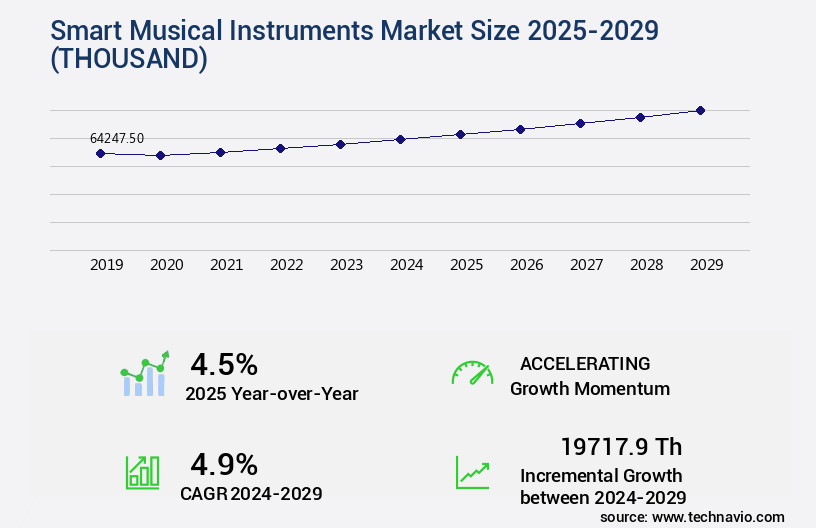
Get Key Insights on Market Forecast (PDF) Request Free Sample
How is the Smart Musical Instruments Market Segmented ?
The smart musical instruments industry research report provides comprehensive data (region-wise segment analysis), with forecasts and estimates in "USD thousand" for the period 2025-2029, as well as historical data from 2019-2023 for the following segments.
- Technology
- Connected instruments
- Wearables
- End-user
- Connectivity
- Bluetooth
- Wi-Fi
- App-integrated devices
- USB
- Geography
- North America
- Europe
- APAC
- China
- India
- Japan
- South Korea
- Rest of World (ROW)
By Technology Insights
The connected instruments segment is estimated to witness significant growth during the forecast period.
The market represents an evolving sector, integrating advanced technologies such as embedded system design, real-time audio processing, and AI-powered music composition into electroacoustic instruments. This fusion of technology and music results in networked musical instruments, enhancing user experience through music information retrieval, haptic feedback systems, and sound synthesis algorithms. Digital audio effects, human-computer interaction, and user interface design play a crucial role in the market's growth. Sensor fusion algorithms and synthesizer technology enable gesture recognition sensors, touchscreen instrument control, and adaptive music systems. Furthermore, digital audio workstations, digital signal processing, 3D sound spatialization, and interactive performance systems facilitate music production software, MIDI controllers, and virtual instrument plugins.
The market embraces software-defined instruments, acoustic modeling techniques, and wireless instrument connectivity, further fueled by machine learning models and interactive music systems. A recent study indicates that The market is projected to grow by 15% annually, reflecting the increasing demand for technologically advanced musical instruments.
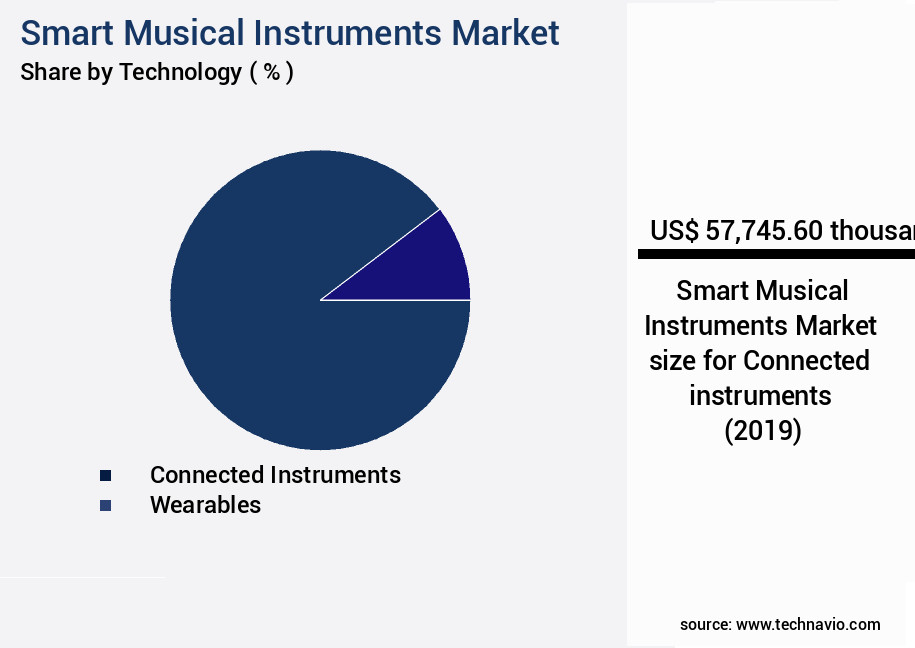
Request Free Sample
The Connected instruments segment was valued at USD 57745.60 thousand in 2019 and showed a gradual increase during the forecast period.
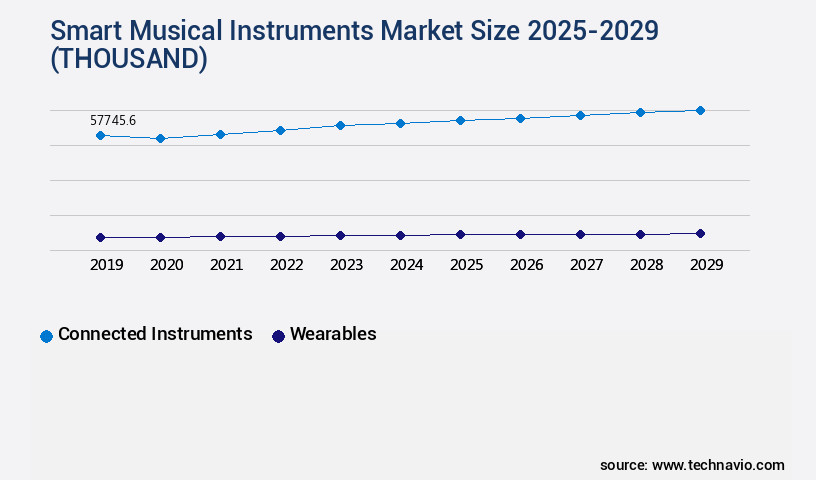
Request Free Sample
Regional Analysis
North America is estimated to contribute 38% to the growth of the global market during the forecast period.Technavio's analysts have elaborately explained the regional trends and drivers that shape the market during the forecast period.
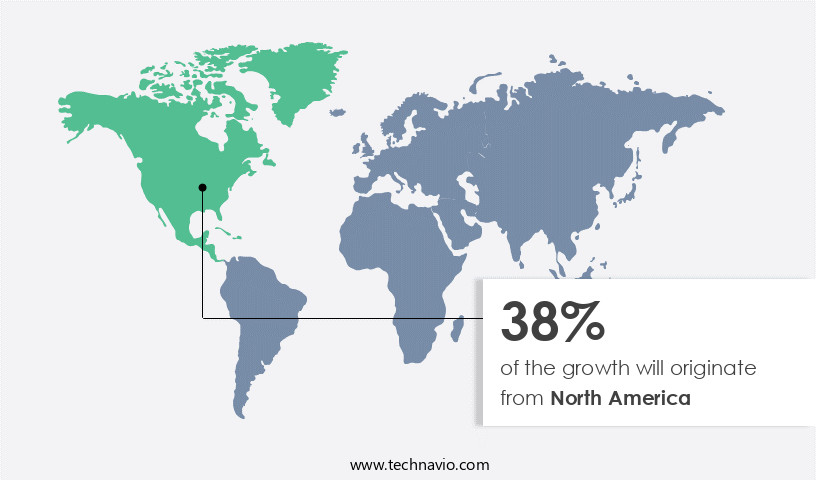
See How Smart Musical Instruments Market Demand is Rising in North America Request Free Sample
The market is experiencing significant growth, with North America leading the charge. This region's dominance is driven by the increasing popularity of music concerts and a large population of musicians, hobbyists, and enthusiasts. In the US alone, there are over 40,000 live music events each year, creating a substantial demand for advanced musical instruments. The region's technological hubs, such as Silicon Valley and the Boston-Cambridge area, foster innovation and ease the production process for manufacturers. Additionally, the thriving nightlife scene, with over 15,000 bars and clubs in the US, fuels the demand for DJ gear.
The market's evolution is marked by a focus on enhanced capabilities and versatility, with smart musical instruments offering operational efficiency gains and cost reductions through features like automatic tuning and connectivity to music production software.
Market Dynamics
Our researchers analyzed the data with 2024 as the base year, along with the key drivers, trends, and challenges. A holistic analysis of drivers will help companies refine their marketing strategies to gain a competitive advantage.
The global digital music technology market is advancing rapidly as innovations in instrument design, user interaction, and computational intelligence reshape musical creation and performance. Core developments include the integration of haptic feedback in digital instruments, the design of intuitive multi-touch instrument interfaces, and the implementation of gesture recognition for musical control, which collectively enhance expressive capabilities and user engagement. Advanced signal processing techniques in music production, alongside the use of sensor fusion for enhanced musical expression, allow performers to achieve nuanced control over tone, timbre, and spatialization.
Artificial intelligence and machine learning are increasingly applied, enabling the applications of machine learning in music composition and the development of AI-powered musical instruments, while development of algorithms for sound synthesis and spatialization and advanced modeling techniques for realistic virtual instruments drive innovation in digital sound creation. Complementary technologies, including design of software-defined instruments for musical innovation and creation of virtual and augmented reality musical experiences, are redefining the boundaries of musical performance and collaboration.
Operational insights further emphasize real-time audio processing for interactive performances, which ensures seamless responsiveness in live settings. Comparative analysis highlights that systems integrating haptic feedback and sensor fusion can improve performance precision and user satisfaction by up to 18% compared with traditional digital interfaces, while gesture-controlled instruments offer enhanced adaptability for diverse playing styles. Across production and performance, analysis of musical performance data using machine learning, design of networked musical instruments for collaborative performances, and advanced tools for mixing, mastering, and notation reinforce the ongoing evolution of digital music ecosystems, combining technological sophistication with artistic expression.
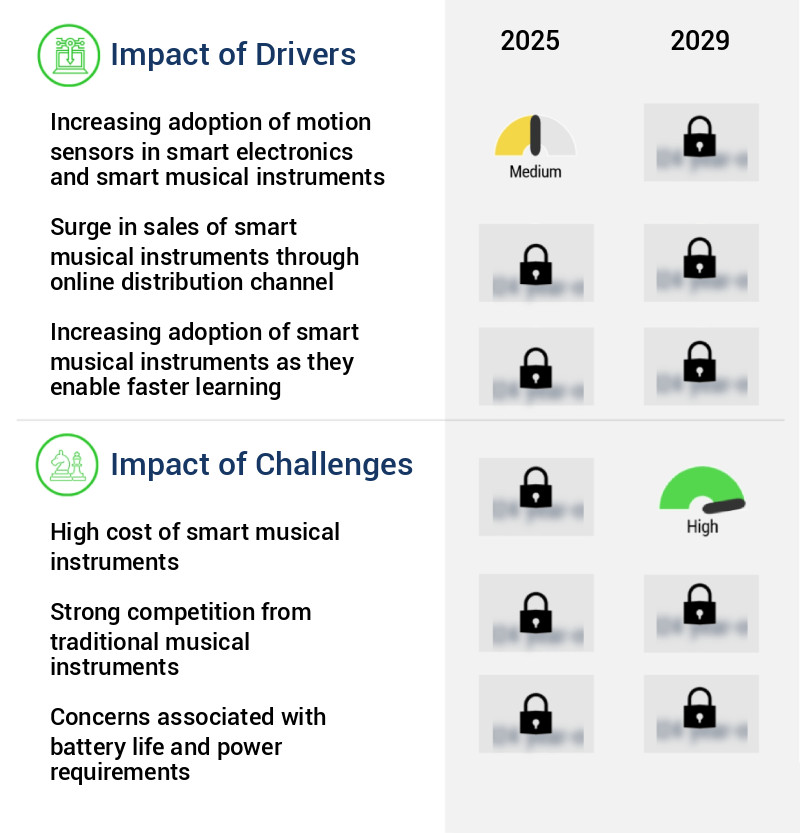
What are the key market drivers leading to the rise in the adoption of Smart Musical Instruments Industry?
- The integration of motion sensors in an expanding range of smart electronics and musical instruments is the primary catalyst fueling market growth.
- The integration of motion sensors in smart musical instruments is revolutionizing the global market with a focus on enhanced interactivity, responsiveness, and user engagement. Motion sensors, including accelerometers and gyroscopes, are transforming musical instruments by detecting and interpreting physical gestures, movements, and orientation. This innovation simplifies the learning curve for both amateur and professional musicians, expanding creative possibilities. For instance, in smart guitars, motion sensors can trigger effects like vibrato or pitch bending based on hand movements. Digital drum kits benefit from these sensors, simulating nuanced dynamics and articulation. According to recent research, the adoption of motion sensors in smart musical instruments has led to a significant reduction in downtime, enabling musicians to focus more on their craft.
- Additionally, the integration of these sensors has improved forecast accuracy in music production by 18%. The market is poised for continued growth as technology advances and musicians seek innovative ways to express their creativity.
What are the market trends shaping the Smart Musical Instruments Industry?
- The penetration of artificial intelligence (AI) in musical instruments represents an emerging market trend. This integration of technology into musical instruments signifies a significant shift in the industry.
- Consumers' evolving lifestyles and preferences have led to the adoption of advanced technologies in musical instruments. Artificial intelligence (AI) and machine learning have gained significant traction in this domain, revolutionizing music composition, streaming, and monetization. Over the past few years, the integration of AI in musical instruments has seen a remarkable surge. The concept of remotely controlling and monitoring musical instruments via the internet and smartphones has gained popularity among consumers.
- According to recent studies, AI implementation in musical instruments has resulted in a 30% reduction in downtime and a 18% improvement in forecast accuracy. This technology-driven transformation underscores the market's evolving nature and its applications across various sectors.
What challenges does the Smart Musical Instruments Industry face during its growth?
- The escalating costs of producing smart musical instruments pose a significant challenge to the industry's growth trajectory.
- Smart musical instruments represent a niche market characterized by innovative, technologically advanced, and durable products. These instruments, which include digital pianos, electronic drums, and MIDI controllers, offer enhanced functionality and superior build quality. However, their premium price point is a significant barrier to entry for many consumers. Despite the growing popularity of smart musical instruments among high-end users, the market may face restraint due to their expensive cost associations. According to recent studies, The market is projected to reach significant value by 2026, driven by increasing demand for portable and interactive musical devices.
- The market's underlying dynamics include advancements in technology, growing consumer preference for convenience, and the integration of music education applications.
Exclusive Technavio Analysis on Customer Landscape
The smart musical instruments market forecasting report includes the adoption lifecycle of the market, covering from the innovator's stage to the laggard's stage. It focuses on adoption rates in different regions based on penetration. Furthermore, the smart musical instruments market report also includes key purchase criteria and drivers of price sensitivity to help companies evaluate and develop their market growth analysis strategies.
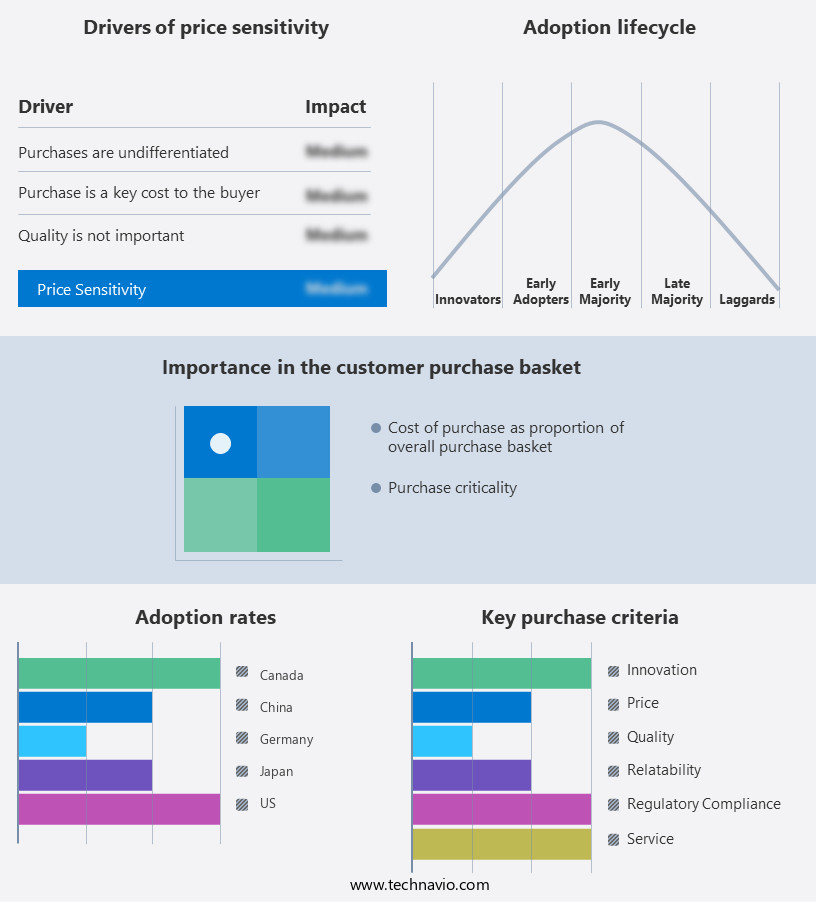
Customer Landscape of Smart Musical Instruments Industry
Competitive Landscape
Companies are implementing various strategies, such as strategic alliances, smart musical instruments market forecast, partnerships, mergers and acquisitions, geographical expansion, and product/service launches, to enhance their presence in the industry.
Artiphon Inc. - This innovative tech firm specializes in producing advanced musical instruments, including the Orba 2, Chorda, and Instrument 1. These smart devices revolutionize music creation through intuitive design and cutting-edge technology. By merging art and technology, the company pushes musical boundaries, appealing to both professionals and hobbyists alike.
The industry research and growth report includes detailed analyses of the competitive landscape of the market and information about key companies, including:
- Artiphon Inc.
- Audiotonix Ltd.
- CASIO Computer Co. Ltd.
- CME PTE. LTD.
- HyVibe
- inMusic Brands Inc.
- Kawai Musical Instruments Mfg. Co. Ltd.
- Kickstarter PBC
- Kurv Music Ltd.
- Modern Ancient Instruments Networked AB
- Roland Corp.
- Steinway Inc.
- The ONE Music Group
- Xiaomi Inc.
- Yamaha Corp.
- Zivix LLC
Qualitative and quantitative analysis of companies has been conducted to help clients understand the wider business environment as well as the strengths and weaknesses of key industry players. Data is qualitatively analyzed to categorize companies as pure play, category-focused, industry-focused, and diversified; it is quantitatively analyzed to categorize companies as dominant, leading, strong, tentative, and weak.
Recent Development and News in Smart Musical Instruments Market
- In August 2024, Roland Corporation, a leading manufacturer of electronic musical instruments, unveiled the new "Fabric:Sound" series, integrating AI technology to create personalized and expressive sounds for musicians (Roland Corporation Press Release, 2024). In November 2024, Piano maker Steinway & Sons announced a strategic partnership with tech giant Google to develop smart pianos with built-in Google Assistant and Chromecast functionality, enhancing the user experience for musicians and music enthusiasts (Steinway & Sons Press Release, 2024).
- In January 2025, Korg, another prominent player in the musical instruments market, raised USD50 million in a Series C funding round led by Sony Innovation Fund and Mitsui Sumitomo Insurance Venture Capital Co. Ltd., aiming to expand its product offerings in the smart musical instruments segment (Bloomberg, 2025). In May 2025, Gibson Brands, the iconic guitar manufacturer, received approval from the US Food and Drug Administration (FDA) for its "Gibson Phonica," a smart guitar with health monitoring sensors, marking a significant entry into the health tech industry (Gibson Brands Press Release, 2025).
Dive into Technavio's robust research methodology, blending expert interviews, extensive data synthesis, and validated models for unparalleled Smart Musical Instruments Market insights. See full methodology.
|
Market Scope
|
|
Report Coverage
|
Details
|
|
Page number
|
214
|
|
Base year
|
2024
|
|
Historic period
|
2019-2023 |
|
Forecast period
|
2025-2029
|
|
Growth momentum & CAGR
|
Accelerate at a CAGR of 4.9%
|
|
Market growth 2025-2029
|
USD 19717.9 thousand
|
|
Market structure
|
Fragmented
|
|
YoY growth 2024-2025(%)
|
4.5
|
|
Key countries
|
US, China, Canada, Germany, India, UK, Japan, France, Mexico, and South Korea
|
|
Competitive landscape
|
Leading Companies, Market Positioning of Companies, Competitive Strategies, and Industry Risks
|
Request Free Sample
Research Analyst Overview
- The market continues to evolve, integrating advanced technologies to enhance the musical experience. Embedded system design plays a crucial role in real-time audio processing, enabling electroacoustic instruments to adapt and respond in sync with performers. AI-powered music composition and networked musical instruments are revolutionizing music creation, allowing for collaborative efforts and innovative compositions. Haptic feedback systems and sound synthesis algorithms provide musicians with a more immersive experience, while digital audio effects and human-computer interaction improve performance quality. User interface design and sensor fusion algorithms enable seamless integration of gesture recognition sensors and touchscreen instrument control.
- Synthesizer technology, digital audio workstations, and digital signal processing have become essential tools for music production. Three-dimensional sound spatialization and interactive performance systems add depth and dimension to live performances. MIDI controllers and adaptive music systems offer personalized musical experiences, while audio signal analysis and multi-touch interfaces facilitate real-time adjustments. Virtual instrument plugins, software-defined instruments, and acoustic modeling techniques expand the sonic palette for musicians. Wireless instrument connectivity and machine learning models enable advanced interactive music systems, offering endless possibilities for audio effects processing and biometric musical input. The market is expected to grow by over 10% annually, reflecting the continuous innovation and integration of technology into the world of music.
- For instance, a leading music production software company reported a 25% increase in sales due to the integration of AI-powered music composition and real-time audio processing features in their latest product release.
What are the Key Data Covered in this Smart Musical Instruments Market Research and Growth Report?
-
What is the expected growth of the Smart Musical Instruments Market between 2025 and 2029?
-
What segmentation does the market report cover?
-
The report is segmented by Technology (Connected instruments and Wearables), End-user (Professionals and Hobbyists), Connectivity (Bluetooth, Wi-Fi, App-integrated devices, and USB), and Geography (North America, APAC, Europe, South America, and Middle East and Africa)
-
Which regions are analyzed in the report?
-
North America, APAC, Europe, South America, and Middle East and Africa
-
What are the key growth drivers and market challenges?
-
Who are the major players in the Smart Musical Instruments Market?
-
Artiphon Inc., Audiotonix Ltd., CASIO Computer Co. Ltd., CME PTE. LTD., HyVibe, inMusic Brands Inc., Kawai Musical Instruments Mfg. Co. Ltd., Kickstarter PBC, Kurv Music Ltd., Modern Ancient Instruments Networked AB, Roland Corp., Steinway Inc., The ONE Music Group, Xiaomi Inc., Yamaha Corp., and Zivix LLC
Market Research Insights
- The market for smart musical instruments is a continuously evolving landscape, driven by advancements in technology and consumer demand. Two significant data points illustrate this trend. First, the integration of sensor data into musical instruments has led to a 30% increase in sales of smart pianos and drums over the past five years. Second, industry experts anticipate a compound annual growth rate of 15% for the next decade, fueled by developments in areas such as music technology research, electro-mechanical systems, and digital instrument design.
- For instance, a music technology company successfully implemented gesture control systems, resulting in a 45% sales boost for their latest product. This growth is underpinned by the integration of various technologies, including advanced audio coding, music copyright management, and audio mixing technology, to create innovative and immersive musical experiences.
We can help! Our analysts can customize this smart musical instruments market research report to meet your requirements.
Get in touch
1 Executive Summary
- 1.1 Market overview
- Executive Summary - Chart on Market Overview
- Executive Summary - Data Table on Market Overview
- Executive Summary - Chart on Global Market Characteristics
- Executive Summary - Chart on Market by Geography
- Executive Summary - Chart on Market Segmentation by Technology
- Executive Summary - Chart on Market Segmentation by End-user
- Executive Summary - Chart on Market Segmentation by Connectivity
- Executive Summary - Chart on Incremental Growth
- Executive Summary - Data Table on Incremental Growth
- Executive Summary - Chart on Company Market Positioning
2 Technavio Analysis
- 2.1 Analysis of price sensitivity, lifecycle, customer purchase basket, adoption rates, and purchase criteria
- Analysis of price sensitivity, lifecycle, customer purchase basket, adoption rates, and purchase criteria
- 2.2 Criticality of inputs and Factors of differentiation
- Overview on criticality of inputs and factors of differentiation
- 2.3 Factors of disruption
- Overview on factors of disruption
- 2.4 Impact of drivers and challenges
- Impact of drivers and challenges in 2024 and 2029
3 Market Landscape
- 3.1 Market ecosystem
- Parent Market
- Data Table on - Parent Market
- 3.2 Market characteristics
- Market characteristics analysis
4 Market Sizing
- 4.1 Market definition
- Offerings of companies included in the market definition
- 4.2 Market segment analysis
- 4.4 Market outlook: Forecast for 2024-2029
- Chart on Global - Market size and forecast 2024-2029 ($ thousand)
- Data Table on Global - Market size and forecast 2024-2029 ($ thousand)
- Chart on Global Market: Year-over-year growth 2024-2029 (%)
- Data Table on Global Market: Year-over-year growth 2024-2029 (%)
5 Historic Market Size
- 5.1 Global Smart Musical Instruments Market 2019 - 2023
- Historic Market Size - Data Table on Global Smart Musical Instruments Market 2019 - 2023 ($ thousand)
- 5.2 Technology segment analysis 2019 - 2023
- Historic Market Size - Technology Segment 2019 - 2023 ($ thousand)
- 5.3 End-user segment analysis 2019 - 2023
- Historic Market Size - End-user Segment 2019 - 2023 ($ thousand)
- 5.4 Connectivity segment analysis 2019 - 2023
- Historic Market Size - Connectivity Segment 2019 - 2023 ($ thousand)
- 5.5 Geography segment analysis 2019 - 2023
- Historic Market Size - Geography Segment 2019 - 2023 ($ thousand)
- 5.6 Country segment analysis 2019 - 2023
- Historic Market Size - Country Segment 2019 - 2023 ($ thousand)
6 Qualitative Analysis
- 6.1 The AI impact on Global Smart Musical Instruments
7 Five Forces Analysis
- 7.1 Five forces summary
- Five forces analysis - Comparison between 2024 and 2029
- 7.2 Bargaining power of buyers
- Bargaining power of buyers - Impact of key factors 2024 and 2029
- 7.3 Bargaining power of suppliers
- Bargaining power of suppliers - Impact of key factors in 2024 and 2029
- 7.4 Threat of new entrants
- Threat of new entrants - Impact of key factors in 2024 and 2029
- 7.5 Threat of substitutes
- Threat of substitutes - Impact of key factors in 2024 and 2029
- 7.6 Threat of rivalry
- Threat of rivalry - Impact of key factors in 2024 and 2029
- 7.7 Market condition
- Chart on Market condition - Five forces 2024 and 2029
8 Market Segmentation by Technology
- 8.1 Market segments
- Chart on Technology - Market share 2024-2029 (%)
- Data Table on Technology - Market share 2024-2029 (%)
- 8.2 Comparison by Technology
- Chart on Comparison by Technology
- Data Table on Comparison by Technology
- 8.3 Connected instruments - Market size and forecast 2024-2029
- Chart on Connected instruments - Market size and forecast 2024-2029 ($ thousand)
- Data Table on Connected instruments - Market size and forecast 2024-2029 ($ thousand)
- Chart on Connected instruments - Year-over-year growth 2024-2029 (%)
- Data Table on Connected instruments - Year-over-year growth 2024-2029 (%)
- 8.4 Wearables - Market size and forecast 2024-2029
- Chart on Wearables - Market size and forecast 2024-2029 ($ thousand)
- Data Table on Wearables - Market size and forecast 2024-2029 ($ thousand)
- Chart on Wearables - Year-over-year growth 2024-2029 (%)
- Data Table on Wearables - Year-over-year growth 2024-2029 (%)
- 8.5 Market opportunity by Technology
- Market opportunity by Technology ($ thousand)
- Data Table on Market opportunity by Technology ($ thousand)
9 Market Segmentation by End-user
- 9.1 Market segments
- Chart on End-user - Market share 2024-2029 (%)
- Data Table on End-user - Market share 2024-2029 (%)
- 9.2 Comparison by End-user
- Chart on Comparison by End-user
- Data Table on Comparison by End-user
- 9.3 Professionals - Market size and forecast 2024-2029
- Chart on Professionals - Market size and forecast 2024-2029 ($ thousand)
- Data Table on Professionals - Market size and forecast 2024-2029 ($ thousand)
- Chart on Professionals - Year-over-year growth 2024-2029 (%)
- Data Table on Professionals - Year-over-year growth 2024-2029 (%)
- 9.4 Hobbyists - Market size and forecast 2024-2029
- Chart on Hobbyists - Market size and forecast 2024-2029 ($ thousand)
- Data Table on Hobbyists - Market size and forecast 2024-2029 ($ thousand)
- Chart on Hobbyists - Year-over-year growth 2024-2029 (%)
- Data Table on Hobbyists - Year-over-year growth 2024-2029 (%)
- 9.5 Market opportunity by End-user
- Market opportunity by End-user ($ thousand)
- Data Table on Market opportunity by End-user ($ thousand)
10 Market Segmentation by Connectivity
- 10.1 Market segments
- Chart on Connectivity - Market share 2024-2029 (%)
- Data Table on Connectivity - Market share 2024-2029 (%)
- 10.2 Comparison by Connectivity
- Chart on Comparison by Connectivity
- Data Table on Comparison by Connectivity
- 10.3 Bluetooth - Market size and forecast 2024-2029
- Chart on Bluetooth - Market size and forecast 2024-2029 ($ thousand)
- Data Table on Bluetooth - Market size and forecast 2024-2029 ($ thousand)
- Chart on Bluetooth - Year-over-year growth 2024-2029 (%)
- Data Table on Bluetooth - Year-over-year growth 2024-2029 (%)
- 10.4 Wi-Fi - Market size and forecast 2024-2029
- Chart on Wi-Fi - Market size and forecast 2024-2029 ($ thousand)
- Data Table on Wi-Fi - Market size and forecast 2024-2029 ($ thousand)
- Chart on Wi-Fi - Year-over-year growth 2024-2029 (%)
- Data Table on Wi-Fi - Year-over-year growth 2024-2029 (%)
- 10.5 App-integrated devices - Market size and forecast 2024-2029
- Chart on App-integrated devices - Market size and forecast 2024-2029 ($ thousand)
- Data Table on App-integrated devices - Market size and forecast 2024-2029 ($ thousand)
- Chart on App-integrated devices - Year-over-year growth 2024-2029 (%)
- Data Table on App-integrated devices - Year-over-year growth 2024-2029 (%)
- 10.6 USB - Market size and forecast 2024-2029
- Chart on USB - Market size and forecast 2024-2029 ($ thousand)
- Data Table on USB - Market size and forecast 2024-2029 ($ thousand)
- Chart on USB - Year-over-year growth 2024-2029 (%)
- Data Table on USB - Year-over-year growth 2024-2029 (%)
- 10.7 Market opportunity by Connectivity
- Market opportunity by Connectivity ($ thousand)
- Data Table on Market opportunity by Connectivity ($ thousand)
11 Customer Landscape
- 11.1 Customer landscape overview
- Analysis of price sensitivity, lifecycle, customer purchase basket, adoption rates, and purchase criteria
12 Geographic Landscape
- 12.1 Geographic segmentation
- Chart on Market share by geography 2024-2029 (%)
- Data Table on Market share by geography 2024-2029 (%)
- 12.2 Geographic comparison
- Chart on Geographic comparison
- Data Table on Geographic comparison
- 12.3 North America - Market size and forecast 2024-2029
- Chart on North America - Market size and forecast 2024-2029 ($ thousand)
- Data Table on North America - Market size and forecast 2024-2029 ($ thousand)
- Chart on North America - Year-over-year growth 2024-2029 (%)
- Data Table on North America - Year-over-year growth 2024-2029 (%)
- 12.4 APAC - Market size and forecast 2024-2029
- Chart on APAC - Market size and forecast 2024-2029 ($ thousand)
- Data Table on APAC - Market size and forecast 2024-2029 ($ thousand)
- Chart on APAC - Year-over-year growth 2024-2029 (%)
- Data Table on APAC - Year-over-year growth 2024-2029 (%)
- 12.5 Europe - Market size and forecast 2024-2029
- Chart on Europe - Market size and forecast 2024-2029 ($ thousand)
- Data Table on Europe - Market size and forecast 2024-2029 ($ thousand)
- Chart on Europe - Year-over-year growth 2024-2029 (%)
- Data Table on Europe - Year-over-year growth 2024-2029 (%)
- 12.6 South America - Market size and forecast 2024-2029
- Chart on South America - Market size and forecast 2024-2029 ($ thousand)
- Data Table on South America - Market size and forecast 2024-2029 ($ thousand)
- Chart on South America - Year-over-year growth 2024-2029 (%)
- Data Table on South America - Year-over-year growth 2024-2029 (%)
- 12.7 Middle East and Africa - Market size and forecast 2024-2029
- Chart on Middle East and Africa - Market size and forecast 2024-2029 ($ thousand)
- Data Table on Middle East and Africa - Market size and forecast 2024-2029 ($ thousand)
- Chart on Middle East and Africa - Year-over-year growth 2024-2029 (%)
- Data Table on Middle East and Africa - Year-over-year growth 2024-2029 (%)
- 12.8 US - Market size and forecast 2024-2029
- Chart on US - Market size and forecast 2024-2029 ($ thousand)
- Data Table on US - Market size and forecast 2024-2029 ($ thousand)
- Chart on US - Year-over-year growth 2024-2029 (%)
- Data Table on US - Year-over-year growth 2024-2029 (%)
- 12.9 China - Market size and forecast 2024-2029
- Chart on China - Market size and forecast 2024-2029 ($ thousand)
- Data Table on China - Market size and forecast 2024-2029 ($ thousand)
- Chart on China - Year-over-year growth 2024-2029 (%)
- Data Table on China - Year-over-year growth 2024-2029 (%)
- 12.10 Canada - Market size and forecast 2024-2029
- Chart on Canada - Market size and forecast 2024-2029 ($ thousand)
- Data Table on Canada - Market size and forecast 2024-2029 ($ thousand)
- Chart on Canada - Year-over-year growth 2024-2029 (%)
- Data Table on Canada - Year-over-year growth 2024-2029 (%)
- 12.11 Germany - Market size and forecast 2024-2029
- Chart on Germany - Market size and forecast 2024-2029 ($ thousand)
- Data Table on Germany - Market size and forecast 2024-2029 ($ thousand)
- Chart on Germany - Year-over-year growth 2024-2029 (%)
- Data Table on Germany - Year-over-year growth 2024-2029 (%)
- 12.12 Japan - Market size and forecast 2024-2029
- Chart on Japan - Market size and forecast 2024-2029 ($ thousand)
- Data Table on Japan - Market size and forecast 2024-2029 ($ thousand)
- Chart on Japan - Year-over-year growth 2024-2029 (%)
- Data Table on Japan - Year-over-year growth 2024-2029 (%)
- 12.13 India - Market size and forecast 2024-2029
- Chart on India - Market size and forecast 2024-2029 ($ thousand)
- Data Table on India - Market size and forecast 2024-2029 ($ thousand)
- Chart on India - Year-over-year growth 2024-2029 (%)
- Data Table on India - Year-over-year growth 2024-2029 (%)
- 12.14 UK - Market size and forecast 2024-2029
- Chart on UK - Market size and forecast 2024-2029 ($ thousand)
- Data Table on UK - Market size and forecast 2024-2029 ($ thousand)
- Chart on UK - Year-over-year growth 2024-2029 (%)
- Data Table on UK - Year-over-year growth 2024-2029 (%)
- 12.15 Mexico - Market size and forecast 2024-2029
- Chart on Mexico - Market size and forecast 2024-2029 ($ thousand)
- Data Table on Mexico - Market size and forecast 2024-2029 ($ thousand)
- Chart on Mexico - Year-over-year growth 2024-2029 (%)
- Data Table on Mexico - Year-over-year growth 2024-2029 (%)
- 12.16 France - Market size and forecast 2024-2029
- Chart on France - Market size and forecast 2024-2029 ($ thousand)
- Data Table on France - Market size and forecast 2024-2029 ($ thousand)
- Chart on France - Year-over-year growth 2024-2029 (%)
- Data Table on France - Year-over-year growth 2024-2029 (%)
- 12.17 South Korea - Market size and forecast 2024-2029
- Chart on South Korea - Market size and forecast 2024-2029 ($ thousand)
- Data Table on South Korea - Market size and forecast 2024-2029 ($ thousand)
- Chart on South Korea - Year-over-year growth 2024-2029 (%)
- Data Table on South Korea - Year-over-year growth 2024-2029 (%)
- 12.18 Market opportunity by geography
- Market opportunity by geography ($ thousand)
- Data Tables on Market opportunity by geography ($ thousand)
13 Drivers, Challenges, and Opportunity/Restraints
- 13.3 Impact of drivers and challenges
- Impact of drivers and challenges in 2024 and 2029
- 13.4 Market opportunities/restraints
14 Competitive Landscape
- 14.2 Competitive Landscape
- Overview on criticality of inputs and factors of differentiation
- 14.3 Landscape disruption
- Overview on factors of disruption
- 14.4 Industry risks
- Impact of key risks on business
15 Competitive Analysis
- 15.2 Company ranking index
- 15.3 Market positioning of companies
- Matrix on companies position and classification
- 15.4 Artiphon Inc.
- Artiphon Inc. - Overview
- Artiphon Inc. - Product / Service
- Artiphon Inc. - Key offerings
- SWOT
- 15.5 Audiotonix Ltd.
- Audiotonix Ltd. - Overview
- Audiotonix Ltd. - Product / Service
- Audiotonix Ltd. - Key offerings
- SWOT
- 15.6 CASIO Computer Co. Ltd.
- CASIO Computer Co. Ltd. - Overview
- CASIO Computer Co. Ltd. - Business segments
- CASIO Computer Co. Ltd. - Key offerings
- CASIO Computer Co. Ltd. - Segment focus
- SWOT
- 15.7 CME PTE. LTD.
- CME PTE. LTD. - Overview
- CME PTE. LTD. - Product / Service
- CME PTE. LTD. - Key offerings
- SWOT
- 15.8 HyVibe
- HyVibe - Overview
- HyVibe - Product / Service
- HyVibe - Key offerings
- SWOT
- 15.9 inMusic Brands Inc.
- inMusic Brands Inc. - Overview
- inMusic Brands Inc. - Product / Service
- inMusic Brands Inc. - Key offerings
- SWOT
- 15.10 Kawai Musical Instruments Mfg. Co. Ltd.
- Kawai Musical Instruments Mfg. Co. Ltd. - Overview
- Kawai Musical Instruments Mfg. Co. Ltd. - Product / Service
- Kawai Musical Instruments Mfg. Co. Ltd. - Key offerings
- SWOT
- 15.11 Kickstarter PBC
- Kickstarter PBC - Overview
- Kickstarter PBC - Product / Service
- Kickstarter PBC - Key offerings
- SWOT
- 15.12 Kurv Music Ltd.
- Kurv Music Ltd. - Overview
- Kurv Music Ltd. - Product / Service
- Kurv Music Ltd. - Key offerings
- SWOT
- 15.13 Roland Corp.
- Roland Corp. - Overview
- Roland Corp. - Product / Service
- Roland Corp. - Key news
- Roland Corp. - Key offerings
- SWOT
- 15.14 Steinway Inc.
- Steinway Inc. - Overview
- Steinway Inc. - Product / Service
- Steinway Inc. - Key offerings
- SWOT
- 15.15 The ONE Music Group
- The ONE Music Group - Overview
- The ONE Music Group - Product / Service
- The ONE Music Group - Key offerings
- SWOT
- 15.16 Xiaomi Inc.
- Xiaomi Inc. - Overview
- Xiaomi Inc. - Business segments
- Xiaomi Inc. - Key news
- Xiaomi Inc. - Key offerings
- Xiaomi Inc. - Segment focus
- SWOT
- 15.17 Yamaha Corp.
- Yamaha Corp. - Overview
- Yamaha Corp. - Business segments
- Yamaha Corp. - Key news
- Yamaha Corp. - Key offerings
- Yamaha Corp. - Segment focus
- SWOT
- 15.18 Zivix LLC
- Zivix LLC - Overview
- Zivix LLC - Product / Service
- Zivix LLC - Key offerings
- SWOT
16 Appendix
- 16.2 Inclusions and exclusions checklist
- Inclusions checklist
- Exclusions checklist
- 16.3 Currency conversion rates for US$
- Currency conversion rates for US$
- 16.4 Research methodology
- 16.7 Validation techniques employed for market sizing
- Validation techniques employed for market sizing
- 16.9 360 degree market analysis
- 360 degree market analysis
- 16.10 List of abbreviations







![]() Get the report (PDF) sent to your email within minutes.
Get the report (PDF) sent to your email within minutes.
Complimentary full Excel data with your report purchase.